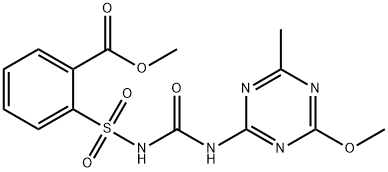Cyprodinil
Synonym(s):4-Cyclopropyl-6-methyl-N-phenylpyrimidin-2-amine
- CAS NO.:121552-61-2
- Empirical Formula: C14H15N3
- Molecular Weight: 225.29
- MDL number: MFCD01632330
- SAFETY DATA SHEET (SDS)
- Update Date: 2024-12-18 14:07:02

What is Cyprodinil?
Chemical properties
White to Off-White Solid
Chemical properties
White crystalline solid or beige powder
The Uses of Cyprodinil
Cyprodinil is a broad-spectrum fungicide of the class of pyrimidinamines. It is commonly used for protection of cereal crops and fruits against fungal infections.
The Uses of Cyprodinil
Agricultural fungicide.
The Uses of Cyprodinil
Cyprodinil is a systemic fungicide which controls a wide range of fungal diseases in cereals, grapes, pome fruits, stone fruits, berries, vegetables, field crops and ornamentals caused by Septoria, Botrytis, Monilinia, Rhynchosporium, etc.
What are the applications of Application
Cyprodinil is a novel broad spectrum anilinopyrimidine antifungal
Definition
ChEBI: A member of the class of aminopyrimidine that is N-phenylpyrimidin-2-amine carrying additional cyclopropyl and methyl substituents at positions 4 and 6 respectively. A broad spectrum fungicide used to control a range of pathogens includi g Tapesia yallundae, Botrytis spp., Alternaria spp. and Rhynchospium secalis. Whilst it is a recognised irritant no serious human health concerns have been identified. It is moderately toxic to birds as w ll as most aquatic organisms and earthworms, but it is not considered toxic to honeybees.
Agricultural Uses
Fungicide: Cyprodinil is applied to the foliage of almonds, grapes, stone fruit crops, and pome fruit crops to control plant diseases. Target fungi for cyprodinil include scab and brown rot blossom
Trade name
CGA 219417® technical; CHORUS®; SWITCH®; UNIX®; VANGUARD®
Potential Exposure
Cyprodinil is an anilino pyrimidine fungicide applied to the foliage of almonds, grapes, stone fruit crops, and pome fruit crops to control plant diseases. Target fungi for cyprodinil include scab and brown rot blossom
Metabolic pathway
After single oral administration of 14C-cyprodinil to rats, cyprodinil is rapidly eliminated principally in the urine. The pattern of the metabolic profile in the urine exhibits a significant sex-related difference with respect to the major metabolite. Males and females both produce N-4- (hydroxyphenyl)-4-cyclopropyl-5-hydroxy-6- methylpyrimidin-2-yl-amine. Female rats conjugate this dihydroxy metabolite with sulfate exclusively at the 5- hydroxypyrimidinyl moiety, while males form equal amounts of the monosulfate and disulfate conjugates. Ten cultures of 12 collected microorganisms produce a monohydroxylated metabolite and the filamentous fungus, Beauveria bassiana ATCC 7159, produces a methoxylated glycoside of the monohydroxylated metabolite. Dihydroxylated metabolites and a molecular cleavage product, 4-cyclopropyl-6-methyl-2- pyrimidinylamine, are detected in certain cultures.
Shipping
UN3082 Environmentally hazardous substances, liquid, n.o.s., Hazard class: 9; Labels: 9-Miscellaneous haz- ardous material, Technical Name Required. UN3077 Environmentally hazardous substances, solid, n.o.s., Hazard class: 9; Labels: 9-Miscellaneous hazardous material, Technical Name Required.
Degradation
Cyprodinil (1) is stable to hydrolytic degradation in pH 5-9 buffer solutions at 25 °C with a DT50 >1 year. Cyprodinil degrades rapidly in water when exposed to UV light (DT50 ca. 14 days) (PM).
Incompatibilities
If this chemical gets into the eyes, remove any contact lenses at once and irrigate immediately for at least 15 minutes, occasionally lifting upper and lower lids. Seek medical attention immediately. If this chemical contacts the skin, remove contaminated clothing and wash immediately with soap and water. Seek medical attention immediately. If this chemical has been inhaled, remove from exposure, begin rescue breathing (using universal precautions) if breathing has stopped, and CPR if heart action has stopped. Transfer promptly to a medical facility. When this chemical has been swallowed, get medical attention. Give large quantities of water and induce vomiting. Do not make an unconscious person vomit. Do not induce vomiting when formulations containing petroleum solvents are ingested.
Waste Disposal
Recycle any unused portion of the material for its approved use or return it to the manu- facturer or supplier. Ultimate disposal of the chemical must consider: the material’s impact on air quality; potential migration in soil or water; effects on animal, aquatic, and plant life; and conformance with environmental and public health regulations.
Properties of Cyprodinil
| Melting point: | 75.9° |
| Boiling point: | 406.0±48.0 °C(Predicted) |
| Density | 1.21 g/cm3 |
| vapor pressure | 5.1 x l0-4 Pa (25 °C) |
| storage temp. | 0-6°C |
| solubility | Chloroform: Slightly Soluble |
| form | neat |
| Water Solubility | 20 mg l-1 (pH 5), 13 mg l-1 (pH 7),
15 mg l-1 (pH 9) 25 °C |
| pka | 4.44 (base) |
| form | Solid |
| color | White to off-white |
| BRN | 7813601 |
| EPA Substance Registry System | Cyprodinil (121552-61-2) |
Safety information for Cyprodinil
| Signal word | Warning |
| Pictogram(s) |
 Exclamation Mark Irritant GHS07  Environment GHS09 |
| GHS Hazard Statements |
H317:Sensitisation, Skin H410:Hazardous to the aquatic environment, long-term hazard |
| Precautionary Statement Codes |
P261:Avoid breathing dust/fume/gas/mist/vapours/spray. P272:Contaminated work clothing should not be allowed out of the workplace. P273:Avoid release to the environment. P280:Wear protective gloves/protective clothing/eye protection/face protection. P302+P352:IF ON SKIN: wash with plenty of soap and water. P333+P313:IF SKIN irritation or rash occurs: Get medical advice/attention. |
Computed Descriptors for Cyprodinil
New Products
(S)-3-Aminobutanenitrile hydrochloride 4-Methylphenylacetic acid N-Boc-D-alaninol N-BOC-D/L-ALANINOL Tert-butyl bis(2-chloroethyl)carbamate 3-Morpholino-1-(4-nitrophenyl)-5,6-dihydropyridin- 2(1H)-one Furan-2,5-Dicarboxylic Acid Tropic acid 1-Bromo-3,5-Di-Tert-Butylbenzene S-2-CHLORO PROPIONIC ACID ETHYL ISOCYANOACETATE 2-Bromo-1,3-Bis(Dimethylamino)Trimethinium Hexafluorophosphate 4-IODO BENZOIC ACID 3-NITRO-2-METHYL ANILINE 1-(2,4-DICHLOROPHENYL) ETHANAMINE (2-Hydroxyphenyl)acetonitrile 4-Bromopyrazole 2-(Cyanocyclohexyl)acetic acid 4-methoxy-3,5-dinitropyridine 1-(4-(aminomethyl)benzyl)urea hydrochloride 2-aminopropyl benzoate hydrochloride diethyl 2-(2-((tertbutoxycarbonyl)amino) ethyl)malonate tert-butyl 4- (ureidomethyl)benzylcarbamate Ethyl-2-chloro((4-methoxyphenyl)hydrazono)acetateRelated products of tetrahydrofuran








You may like
-
 Cyprodinil CAS 121552-61-2View Details
Cyprodinil CAS 121552-61-2View Details
121552-61-2 -
 2033-24-1 98%View Details
2033-24-1 98%View Details
2033-24-1 -
 1975-50-4 98%View Details
1975-50-4 98%View Details
1975-50-4 -
 2-HYDROXY BENZYL ALCOHOL 98%View Details
2-HYDROXY BENZYL ALCOHOL 98%View Details
90-01-7 -
 2-Chloro-1,3-Bis(Dimethylamino)Trimethinium Hexafluorophosphate 221615-75-4 98%View Details
2-Chloro-1,3-Bis(Dimethylamino)Trimethinium Hexafluorophosphate 221615-75-4 98%View Details
221615-75-4 -
 61397-56-6 CIS BROMO BENZOATE 98%View Details
61397-56-6 CIS BROMO BENZOATE 98%View Details
61397-56-6 -
 14714-50-2 (2-Hydroxyphenyl)acetonitrile 98+View Details
14714-50-2 (2-Hydroxyphenyl)acetonitrile 98+View Details
14714-50-2 -
 118753-70-1 98+View Details
118753-70-1 98+View Details
118753-70-1